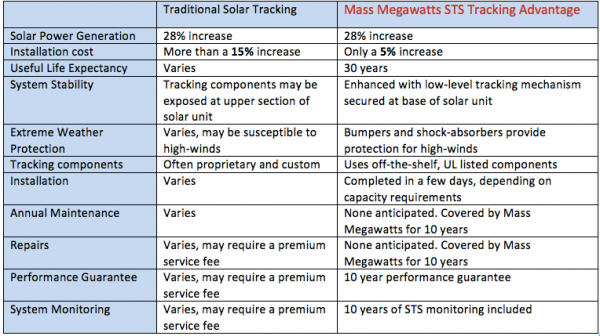The Global and US demand for Solar Tracking

Phoenix, Arizona, April 12, 2023 — McapMediaWire
Introduction
Picture this: A world where renewable energy is the norm, and we are no longer dependent on fossil fuels. Solar energy is one of the most promising sources of renewable energy, and with technological advancements, it has become more efficient and affordable. However, to maximize the potential of solar energy, solar tracking is essential. In this blog post, we will explore the global and US demand for solar tracking, the factors driving this demand, the challenges faced by the industry, and the key players in the market.
![]()
What is Solar Tracking?
Solar tracking refers to the process of following the path of the sun to increase the efficiency of solar panels. The sun’s position changes throughout the day, and solar panels that are stationary can only capture a limited amount of sunlight. Solar tracking systems enable solar panels to move with the sun, ensuring that they receive maximum sunlight and produce maximum energy.
There are two types of solar tracking systems: single-axis and dual-axis. Single-axis systems track the sun’s movement from east to west, while dual-axis systems track both the east-west movement and the inclination of the sun. Dual-axis systems are more efficient but are also more expensive.
Solar tracking is not a new concept. The first solar tracking system was developed in the 16th century by astronomer Johannes Kepler. However, it is only in recent years that solar tracking has become more popular in the solar energy industry.

Advantages of Solar Tracking
The primary advantage of solar tracking is increased energy efficiency. Solar tracking systems can increase the energy output of solar panels by up to 25%. This increase in efficiency means that solar tracking systems can generate more energy per square foot of solar panel, reducing the overall cost of solar energy.
Solar tracking systems can also increase the lifespan of solar panels. By reducing the amount of stress on the panels, solar tracking systems can prolong their lifespan, reducing the need for frequent replacements.
Finally, solar tracking systems can be designed to be more aesthetically pleasing. By using innovative designs, solar tracking systems can blend in with their surroundings, reducing their visual impact.

Global Demand for Solar Tracking
The global demand for solar tracking is increasing rapidly. According to a report by ResearchAndMarkets.com, the global solar tracker market is expected to grow at a CAGR of 17.3% between 2020 and 2025. This growth is being driven by several factors, including:
-
The increasing demand for renewable energy sources
-
The decreasing cost of solar energy
-
The need to reduce greenhouse gas emissions
The report also notes that the Asia-Pacific region is expected to dominate the solar tracker market, with China and India being the largest markets. Europe and North America are also expected to see significant growth in the solar tracker market over the next few years.
![]()
Solar Tracker Market Size, Growth, Trends, Report 2022-2030 (precedenceresearch.com)
US Demand for Solar Tracking
In the US, the demand for solar tracking is also on the rise. According to a report by the National Renewable Energy Laboratory, 80% of new solar installations in the US are now using tracking systems. This trend is expected to continue, with the report predicting that solar tracking will become the norm for large-scale solar installations.
The report notes that the increasing demand for solar tracking is due to several factors, including:
-
The decreasing cost of solar tracking systems >The increasing efficiency of solar tracking systems
-
The need to increase the output of solar installations
The report also notes that the Southwest region of the US is the largest market for solar tracking, with California being the largest state market.

Solar Tracker Market Size, Share, Analysis & Growth by [2029] (fortunebusinessinsights.com)
Factors Driving the Demand for Solar Tracking
The demand for solar tracking is being driven by several factors, including:
-
The increasing demand for renewable energy sources
-
The decreasing cost of solar energy
-
The need to reduce greenhouse gas emissions
-
The increasing efficiency of solar tracking systems
-
The need to increase the output of solar installations
As the world becomes more aware of the impact of climate change, the demand for renewable energy sources is increasing. Solar energy is one of the most promising sources of renewable energy, and solar tracking systems are essential to maximizing its potential.
The decreasing cost of solar energy is also driving the demand for solar tracking. As the cost of solar energy decreases, the demand for solar installations is increasing. Solar tracking systems can increase the output of solar installations, reducing the overall cost of solar energy.
Challenges Faced by the Solar Tracking Industry
The solar tracking industry is not without its challenges. One of the biggest challenges is the cost of solar tracking systems. While the cost of solar energy has decreased significantly in recent years, solar tracking systems are still relatively expensive. This cost can be a barrier to entry for some consumers.
Another challenge is the complexity of solar tracking systems. Solar tracking systems require sophisticated technology to track the sun’s movement accurately. This technology can be challenging to develop and maintain, adding to the cost of solar tracking systems.
Finally, the visual impact of solar tracking systems can be a concern for some consumers. While solar tracking systems can be designed to be more aesthetically pleasing, they are still large structures that can be visually intrusive.
Key Players in the Solar Tracking Industry
There are several key players in the solar tracking industry, including:
-
NEXTracker
-
Soltec
-
Array Technologies
These companies are at the forefront of solar tracking technology, developing innovative solutions to increase the efficiency of solar energy.
Conclusion
Solar tracking to maximize the potential of solar energy. The global and US demand for solar tracking is increasing rapidly, driven by the decreasing cost of solar energy, the need to reduce greenhouse gas emissions, and the increasing efficiency of solar tracking systems. While the solar tracking industry faces several challenges, the key players in the market are developing innovative solutions to overcome these challenges and increase the efficiency of solar energy.
Contact:
Mcap MediaWire
(707) 682-9473
cs@mcapmedia.com
Twitter: @mcapmediawire
FB: @mcapmediawire
IG: @mcapmediawire
Linkedin: @mcapmediawire
Linktree: @mcapmediawire
Pinterest: @mcapmediawire
YouTube: @mcapmediawire




